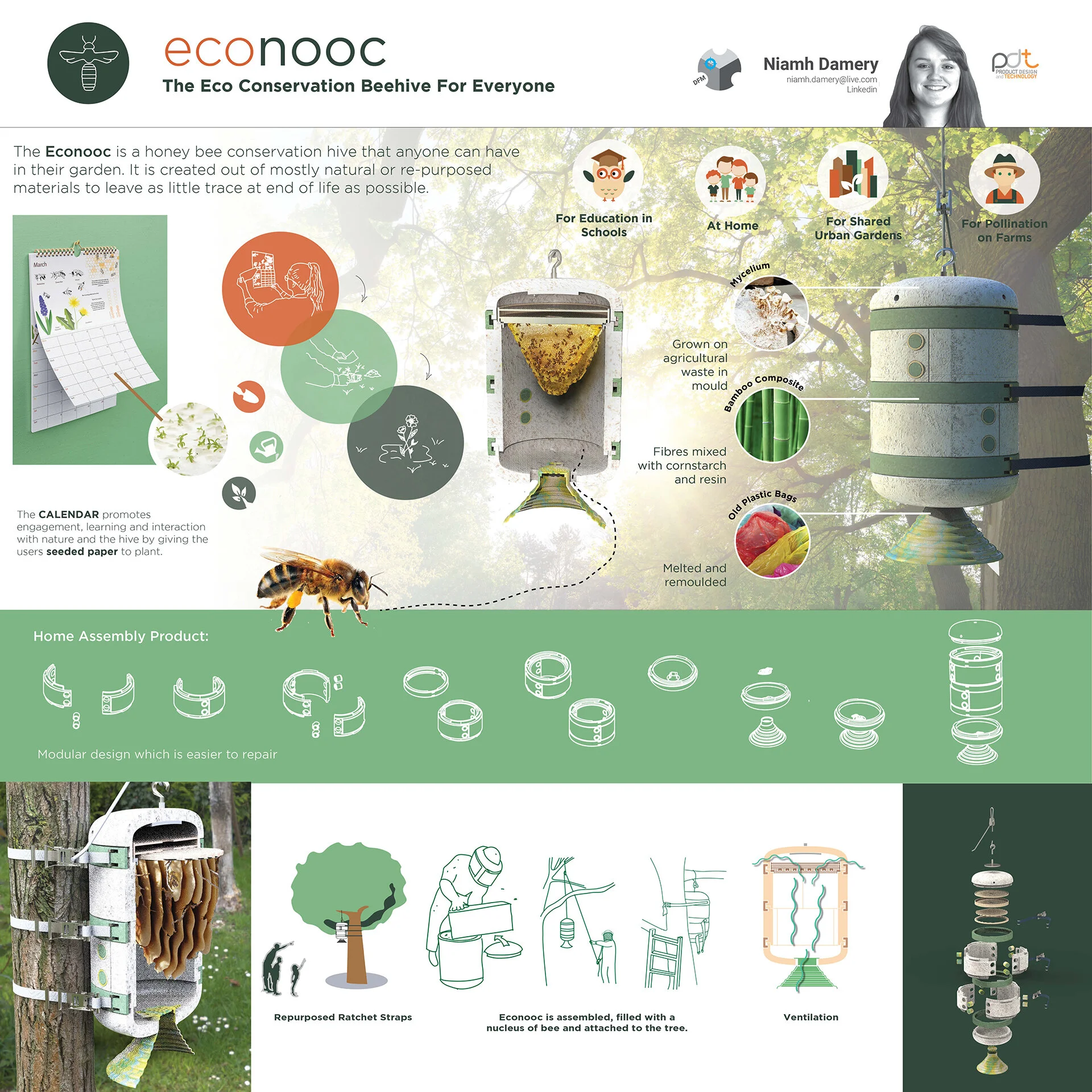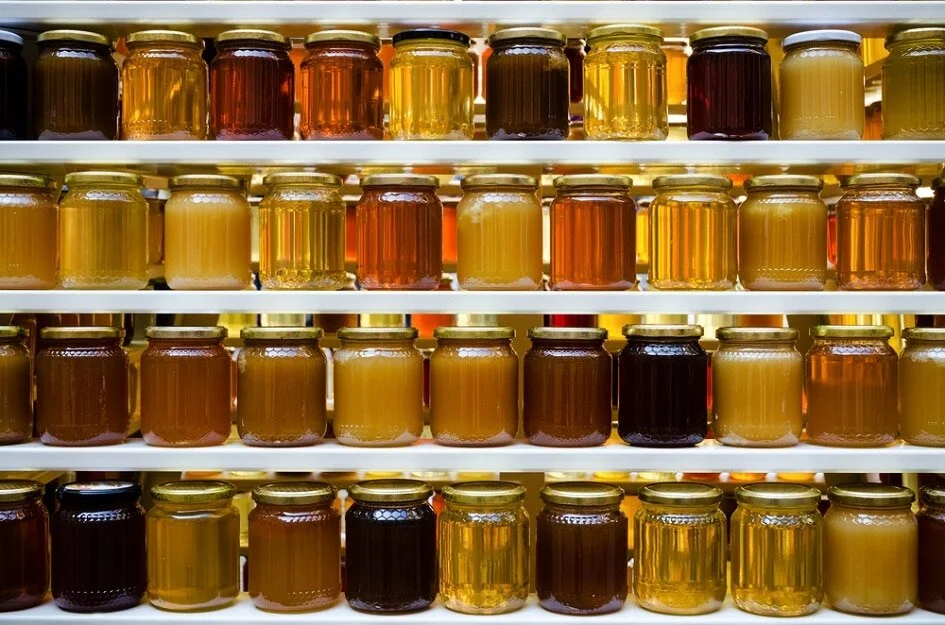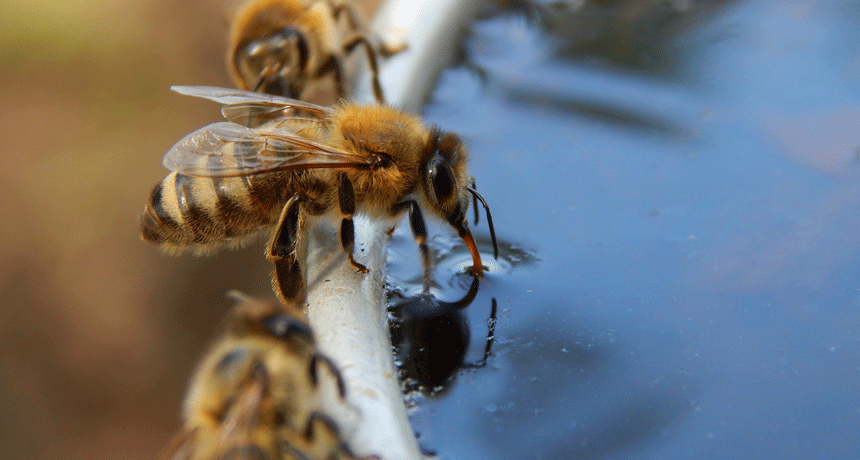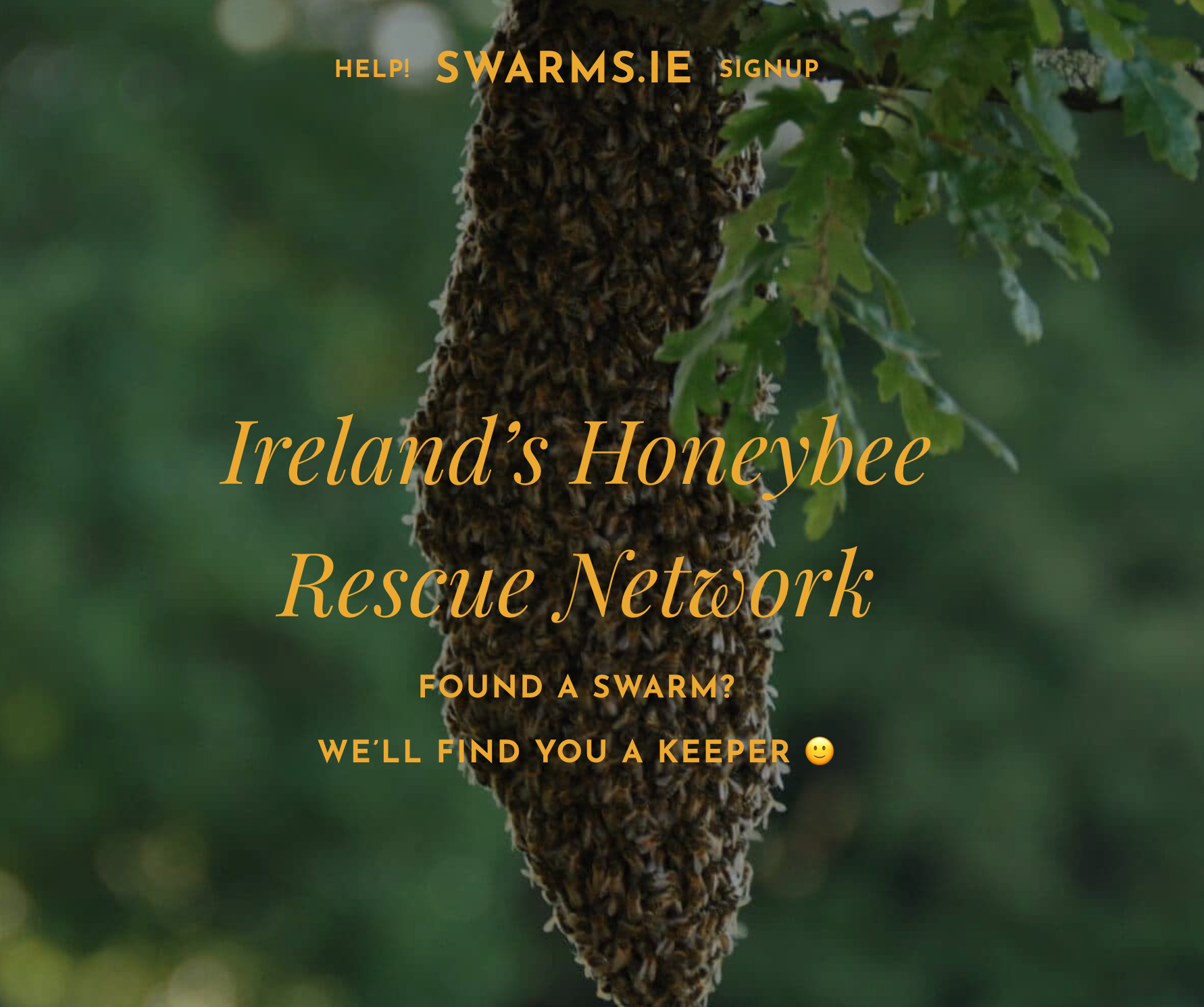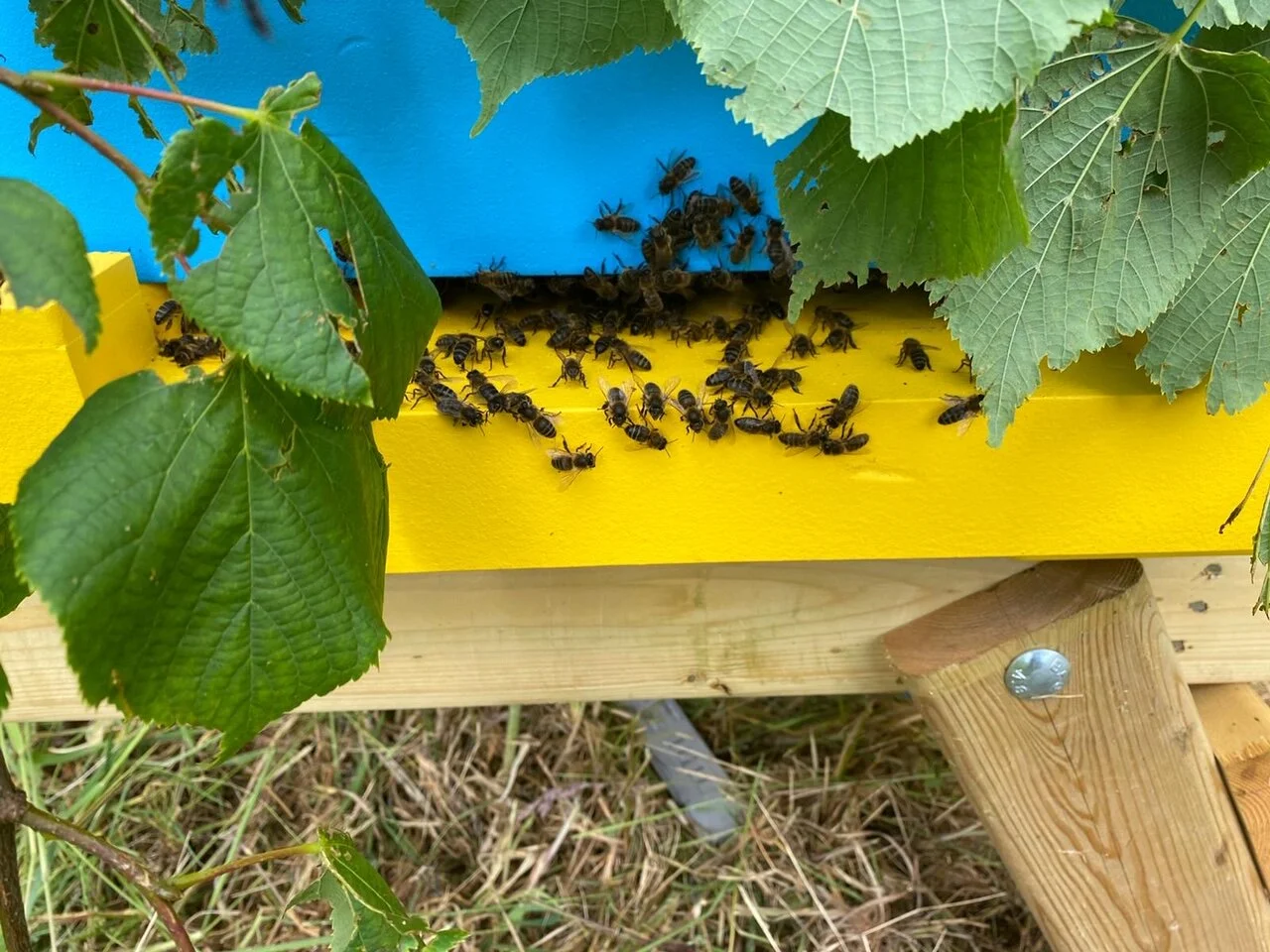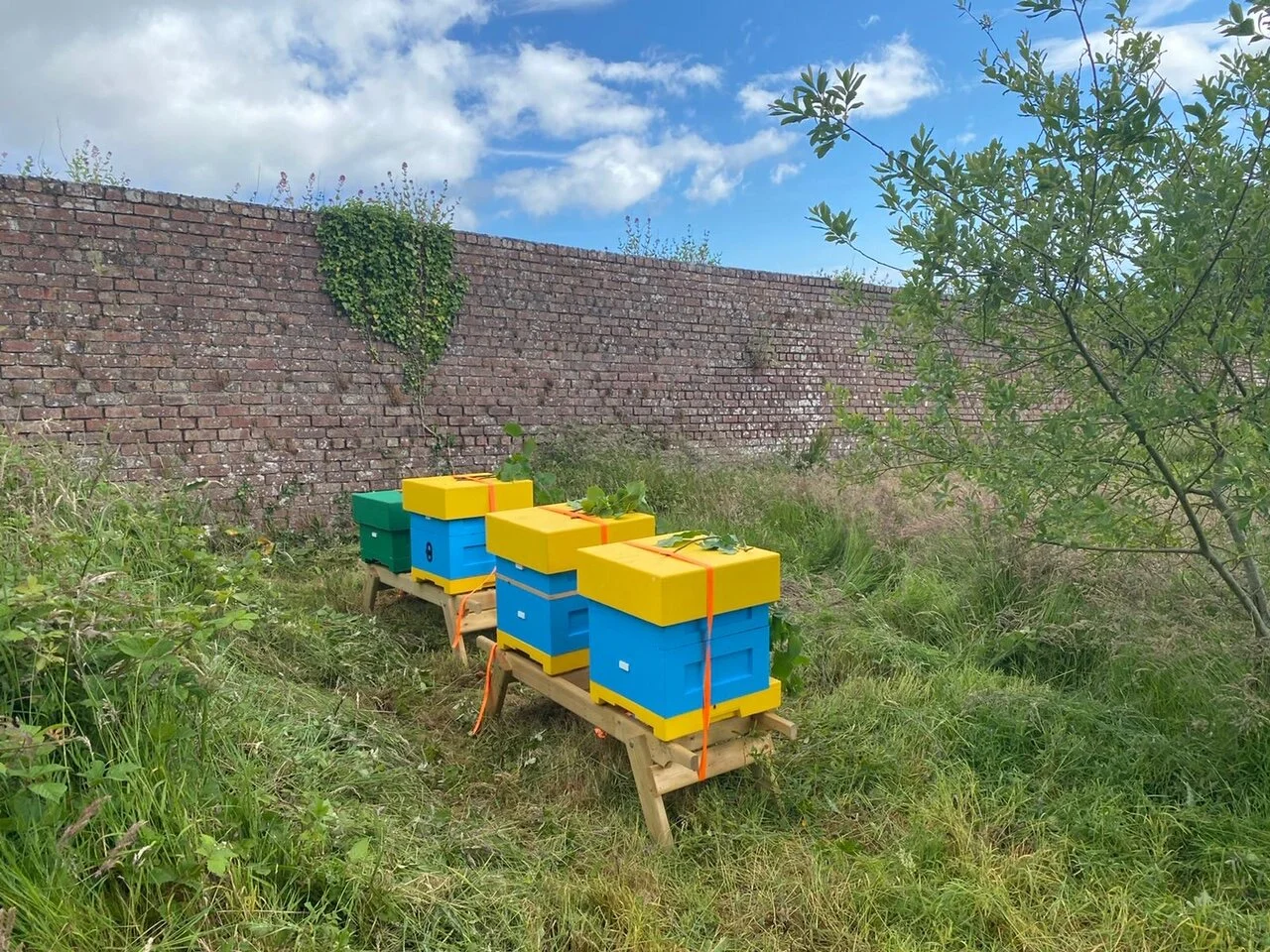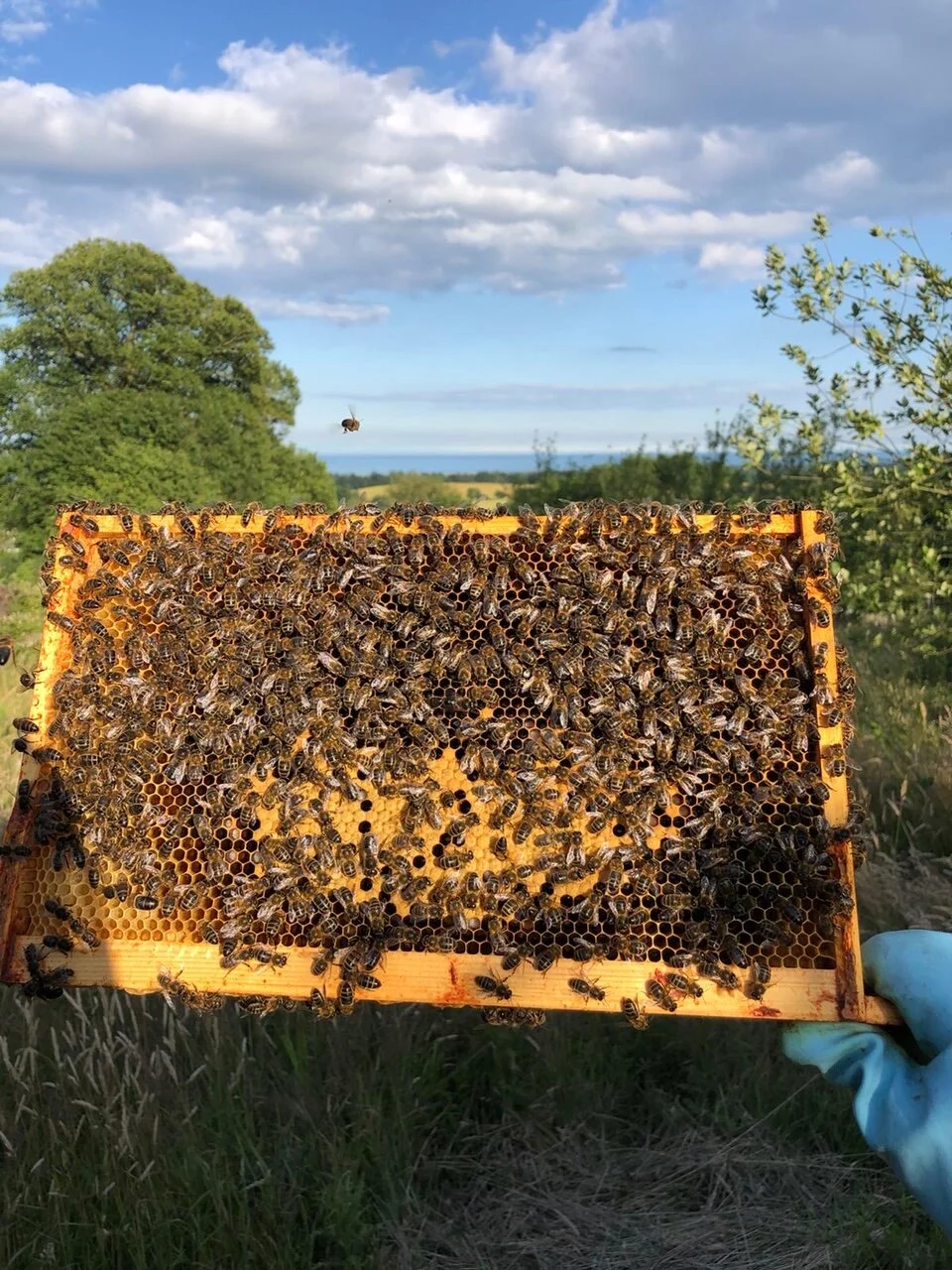We recently stumbled across this piece on Instagram. It’s a worker bee in Aberdeen by an Italian graffiti and tattoo artist called Web3e. Check out much more of his work here: https://www.instagram.com/web3e/
LEGO Bee
A little fun with Lego.
Check out the instructions here, courtesy of Jessica Farrell and thanks to the Heritage Council.
Book Recommendation: The Book of Bees by Piotr Socha
We absolutely love this book. The artwork, the detail, the information, the layout and the accessibility of it for children and adults alike. How doe bees communicate? How do bees procreate? What is a swarm? What do beekeepers wear? How is a hive put together? When did beekeeping begin? So many questions are answered in this beautiful 72 page hardback book. One of our favourites.
You can buy it in (or via their online store) one of our favourite Iocal bookshops - Tales for Tadpoles.
Naimh Damery's Econooc
An article in the Irish Times piqued our interest this week detailing a UL student who had won an award for her eco-friendly hive designed mostly from natural or re-purposed materials. It’s a fascinating project that could work really well in many contexts. We will be watching closely as it develops. Lots more reading below!
Further reading:
Honeybee Wings
We recently came across this very cool image of the wings of a honeybee on the Blind Bee Honey page on Facebook and thought we would share it.
The wings of a honey bee are fascinating in terms of their complexity and power. Here are some facts about them:
Honey bees can travel at 15 miles per hour thanks to their wings
The wings are arranged in two pairs
The wings are connected together by a row of hooks on the hind wing
The forewings are much larger than the hind wings
The wings are flexible and bend a lot mid-flight
As bees take off the wings twist as well as moving up and down
Bees use their wings to create airflow through the hive for ventilation purposes
They also flap wings to disperse harmful or unwelcome pheromones
Photo courtesy of Blind Bee Honey.
Irish Made Awards Finalists!
We are chuffed to make it into the final of the food category of the Irish Country Magazine’s Irish Made Awards this year. Over 350 businesses applied and we are one of the chosen few to get through to the final following the judges deliberation. Next up is a public vote. You can vote here: https://irishcountrymagazine.ie/vote2020/ until September 30th!
Are you an Irish business owner or entrepreneur creating a beautiful product in Ireland? We want to find the makers, creators, craftspeople and businesses that make buying Irish so great. Whether you’re a sole trader or an SME exporting internationally, if you are made in Ireland, we want to hear from you. The awards will be open to businesses in the following categories, and an esteemed panel of judges will have the hard task of narrowing down the finalists in each category, which will then go to a live vote on http://www.irishcountrymagazine.ie in September.
Girl Next Door Honey
Girl Next Door Honey is a website run by a beekeeper in San Diego, USA called Hilary Kearney. It’s an informative, well laid-out and has a brilliant blog attached to it called Beekeeping Like A Girl. We’ve found many fascinating articles and excellent photographs all across the site, blog and Instagram handle. Some of it is advice, other articles are opinion pieces - there is plenty of content for all standards of beekeepers. Of particular fun, especially for beginners, are the Queen Spotting photographs (see below) where Hilary asks you to find the Queen in a picture taken from one of her hives. There is also a shop with books, posters, bee suits and fun items like stickers and magnets. Well worth a gander!
Here are the various links you need:
Website: https://girlnextdoorhoney.com/
Instagram account: https://www.instagram.com/girlnextdoorhoney/
(Photos courtesy of the website and Instagram account of Hilary Kearney)
Different Types of Honey
There are many different types of honey available both in Ireland and abroad. In this post we are going to look at some of the more well known honeys and give a little bit of information about each of them.
Acacia Honey - acacia honey comes from what’s called the black locust tree or “false acacia” tree, usually the Robinia pseudoacacia or Caragana arborescens species. It is very popular in Germany, Bulgaria and Hungary.
Light amber colour
Very sweet but light taste with floral accents
High in fructose and low in glucose
Slow to crystallise
Citrus Honey - comes from orchards of different fruits. The nectar can come from: oranges, grapefruit, lemons, mandarins, tangerines, limes and many others. Many Mediterranean countries produce citrus honey.
Very light in colour
Fresh and floral taste
Medium sweetness and low acidity
Forest Honey - different to most honeys as the honey is made from honeydew, a sugary secretion left on trees by insects. The bees collect, store and convert this into honey. Common across Europe.
Dark or very dark in colour
Very little crystallisation
Medium sweetness
Taste depends on trees involved
Heather Honey - the western European answer to Manuka honey, heather honey is hard to extract due to its thickness but well known for it’s healing properties and taste. Found in Ireland and in the UK.Dark-coloured honey
Mild, sweet taste with a tangy aftertaste
Thixotropic consistency, which means it only becomes more liquid when stirred, shaken, or agitated.
Pungent aroma
Manuka Honey - Produced in New Zealand this honey is expensive due to the small window in which the plant flowers and the distance it needs to travel to get to our market. It’s widely recognised as a superfood honey with distinctive and measurable health benefits.
Rare, dark-coloured honey
Rich and sweet flavour
From the flowers of the Tea Tree bush
Better known more for its health benefits than its flavour
Sunflower Honey - Sunflowers or Heliantus Annus produce thousands of seeds and are rich in nectar and pollen. Very popular in Europe, especially Bulgaria and Poland.
Bright, yellowish colour
One of the fastest types of honey to crystallise
High level of glucose and fructose
A medium sweetness with strong acidity
Photo credit: Buram Honey
Honeyland
We came across this film earlier this year and it blew us away. The story, the videography, the central character and of course, the bees. A different pace of life and in a completely different part of the world, Honeyland tells of Hatidze Muratova, a wild beekeeper in the hills of Macedonia. It’s a documentary that took over three years to film and tells us about nature, relationships and human life. The fact that it features some beautiful bee footage is almost an added bonus. Highly recommended from OpenHive HQ!
OpenHive Monthly Newsletter
We have a monthly newsletter that we launched last month. It goes out near the beginning of each month and is full of news about us, about us, about our bees and about events we are involved in. Last Friday we sent out the latest edition that included a new section called Cocktail Corner. You can read the first two newsletters at the links below and if you’d like to sign up you can do that here.




Gliondar - Honey Bee Heaven
Last Wednesday evening RTÉ 2 broadcast a lovely episode of their programme Gliondar that focused on beekeeping in various parts of Ireland. From hobbyists to competitive honey shows and back, the piece covers lots of different angles of beekeeping and is an informative, interesting and heart-warming look at our passion.
A lot gets covered over the course of the 24mins including the Dingle beekeeping scene, a walk though the hives of master beekeeper Eamon Magee, a fascinating look at drones arriving to mate above a field in Tipperary and more. There is something in it for everyone - we highly recommend giving it a watch. And, as a bonus - it is as Gaeilge.
You can watch it on RTÉ Player here.
Bee friendly plants
Over on our Instagram account we have been sharing photos and information about some of the plants that we see our bees foraging on. Today we thought we’d produce a small (and by no means exhaustive!) list of plants that anyone could grow to help bees in your own garden. We’ve also included some tips to make your garden more attractive to bees and links at the end for anyone looking for more details.
Plants: Asters, Bluebells, Crocuses, Geraniums, Poppies, Roses, Snowdrops
Shrubs: Cottoneaster, Fuschia, Lavender, Rosemary
Trees: Apple, Holly, Lime, Sycamore
Tips:
Provide a water source - something with rocks or an edge to it that the bees can perch on.
Plant in clusters. Bees are drawn to groups of a flower as opposed to individuals.
Don’t use any pesticides!
Let weeds grow in your garden.
Plant early flowering trees.
Try to have flowers in the garden all year round.
Further reading:
Pollinator-friendly planting code - Biodiversity Ireland
‘How to make your garden a haven for bees’ - The Irish Times
Flowers for bees - The Federation of Irish Beekeeping (FIBKA)
Photo Credit: Science News
Swarms website
Did you know that there is an Irish website built specifically for the rescuing of swarms of bees? Maintained by a beekeeper the site works as a way of helping people who spot swarms and finding bees a safe place to live. As the site says:
Fine weather prompts the honeybee to swarm, to reproduce as a colony and go out into the world. This is a perfectly natural event, swarming bees mean us no harm.
As a precaution, keep children and animals away from the swarm and do not approach yourself as honeybees can get defensive. They are less likely to sting when swarming than at any other time, but they do not lose the ability to sting. Getting stung once can elicit numerous bees to defend by stinging the same target. Avoid the problem, give them space & respect.
Swarms can collect for short periods on nearly anything while scout bees search for a perfect new abode. Once a suitable location has been agreed up (bees are very democratic!), they all move en masse to the new location, the sight of a cloud of bees moving is something else!
Hard to reach swarms can need extending ladders, cherry pickers or even scaffolding to get up to the spots bees can choose to land on, equipment that is not cheap or straightforward to organise, things that would be best avoided where possible. If a swarm rests low down like on a branch, for a beekeeper this is the least risky rescue to attempt. Time however is critical as at any point the swarm could locate its dream location and fly off to it.
It becomes harder to rehome honeybees once they have entered their new home; this can be a chimney, inside your ESB box, behind guttering going into your attic or inside a cavity of your walls. Sometimes bees locate themselves in places where safe removal is impossible, so it is vital a resting swarm be reported as soon as possible to a local beekeeper.
Not all swarms can be rehomed or should be rehomed, safety is always the main priority. After human safety, potential property damage is the second concern, with bees coming third. It might sound callous to put the bees last, but if we don’t prioritize keeping our keepers safe, we won’t have anyone to look after our bees and their survival will become even more dire.
If you are here to report a swarm and find a local beekeeper, you have come to the right place. We have a network of beekeepers all across Ireland waiting to rescue bees.
Website: https://swarms.ie/
Facebook page: https://www.facebook.com/Irish.swarms/
OpenHive at the Festival of Curiosity 2020
On Friday July 17th at 6pm we will be hosting a virtual tour of one of our hives thanls to the wonderful folk over at the Festival of Curiosity. Kyle will lead you through some of the terminology and processes we use when we are doing a hive inspection. During this busy part of the season we inspect each hive on a weekly basis and this video will show you exactly what we do and why we do it. If you would like to join us please register via this link for free tickets to the tour.
What is the Festival of Curiosity? In their words: Designated as the official legacy project of Dublin City being the European Capital of Science in 2012, the inaugural Festival of Curiosity took place in 2013 and is Dublin’s annual international festival of science, arts, design & technology.
From Playful Days (family programme) to Curious Nights (adult programme) we create, produce & curate unique, visual and interactive cultural experiences in Dublin that merge cutting-edge technology, design, arts and science in playful, immersive & curious ways.
With over 45,000 attendees each year across 14 venues in Dublin City Centre, the festival is Ireland’s annual celebration at the intersection of art, science, technology and design and has quickly grown to be one of the most exciting and innovative festivals of it’s kind in Europe.
The Festival of Curiosity takes a brand new, innovative & research-led approach to audience participation and engagement in science, arts, design & technology for all ages and has sold out every year since it’s inception.
Apiary Focus: Wicklow
We have many apiaries in south Dublin including hives in Churchtown, Ranelagh, Dun Laoghaire, Dalkey and Killiney but our largest apiary is in Wicklow. Until very recently it was in Greystones but for a few different reasons we had to move the ten hives and have been very fortunate to be able to relocate them to private land near Kilquade.
Here are some photos from the new location where the bees are thriving, surrounded by a huge variety of wild flowers and trees.
New items in the store!
We are pleased to announce that our online shop is now selling our raw Irish honey directly to your door in a variety of options. We have two types of products in the store - every day honey that you can you by in 2, 3 or 4 jar packages and a special gift set of 6 jars that arrives in a personalised wooden box. Check it out here.
Note: postage is added at the online checkout.
The June Gap
June can be a difficult time for bees as they enter what is known as the ‘June Gap’. The majority of their sources of spring nectar and pollen are over and the summer plants are not yet flowering. The population of the hive will be nearing its highest point (50-60,000 bees!) in preparation for the summer nectar. The June Gap can depend a lot on the weather and the temperature. Some years there is no June gap as the brambles and clover start flowering early and other years it can last for three weeks. We will have to wait and see what will happen this year! It can always help to plant early June flowering species like these gorgeous alliums!
OpenHive honey on the shelves
We are constantly expanding the stockists of our raw Irish honey in Dublin. You can also purchase our OH jars in the following stores:
Cavistons Food Emporium (Glasthule, Dublin)
NeighbourFood Market @ The Cali Kitchen (Dun Laoghaire, Dublin)
The Hopsack (Rathmines, Dublin)
The Punnet Health Store (Glasthule, Dublin)
Two Beans Cafe (Dun Laoghaire, Dublin)
Weeklie (Dublin grocery delivery service)
Enjoy!
Photo by Sarah-Kim Watchorn
The OpenHive blog is go
Here at OpenHive HQ we are very keen on developing a community of people who want to learn about beekeeping, find out more about our honey-making process and be part of the journey that we are on. To that end we have decided to start a blog - we will post an article each week to share information with you all from the apiaries to the shops, from the bees to the plants. We hope you enjoy it.






